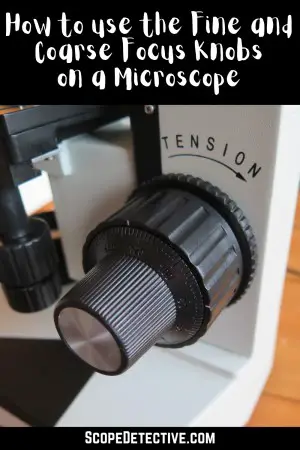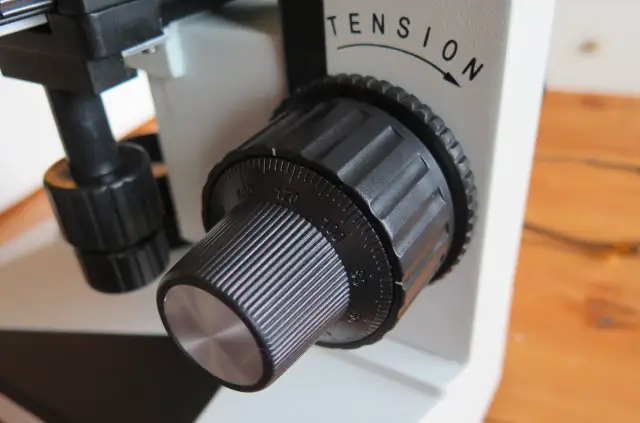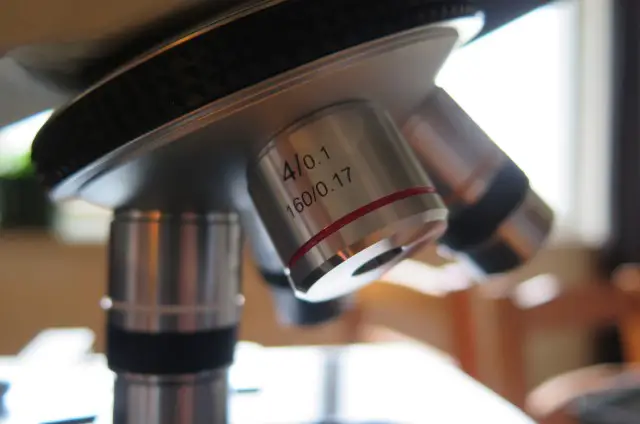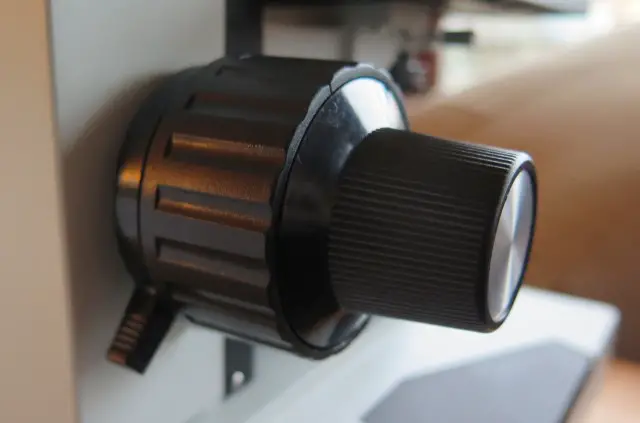Compound microscopes have fine and coarse focus knobs which are used to – of course – achieve focus on the specimen.
These knobs are also known as the ‘stage adjustment knobs’ because they literally adjust the stage up and down.
In this article, I’ll outline everything you need to know about the focus knobs on a microscope, including:
- What they do
- The Difference between Fine and Coarse Focus
- How to use them
- How to use the Stage Stop
- Things to look out for to Protect your Objectives
Let’s get started!

> This article is from our series on the Parts and Functions of a Microscope
1. What does the Stage Adjustment Knob Do on a Microscope?
As the stage gets closer or farther away from the objective, the focus on the specimen will change.
It’s much like when a person who has poor vision moves a book closer and farther from their eyes until they can read the text. Microscopes don’t have ‘auto focus’, so you need to do the focus manually.
2. Where to Find the Focus Knob on a Microscope
The focus knobs on a microscope are located at the base of the arm of the microscope, behind the stage. There is usually one on each side, although some microscopes only have a microscope on the right-hand side.
In general, I find microscopes with a focus knob on each side to be the easiest to work with. I usually control it with both hands – one on each side. It’s just the most comfortable approach for me.
The fine and coarse focus knobs are usually actually on the same knob. You will be able to turn the whole knob if you grab it by the base and turn it. Or, you can turn just the tip of the knob if you just grab the tip!
The coarse focus knob will be the section at the base which makes larger movements, while the fine focus knob will be the section at the tip which makes smaller movements of the stage. You can see both in this image:

3. Difference Between Coarse and Fine Adjustment
Coarse Focus Knob
Most microscopes have a coarse and fine focus knob. However, some microscopes only have a coarse focus knob if they are entry-level beginner microscopes.
The coarse focus knob is the knob which moves the microscope stage a larger distance per rotation.
The purpose of this knob is to get roughly close to the correct focus on the specimen.
Usually, you use the coarse focus knob first and then improve the focus more by reverting to the fine focus knob.
But the coarse focus is also useful for pulling the stage right down for changing specimens and moving the stage to remove the condenser that sits under the stage.
Fine Focus Knob
Because the coarse focus knob moves the stage a larger distance per rotation, it can be hard to perfect the focus with that knob. You’ll move it a tiny bit and you might jump over the best focus.
So, while the coarse focus knob is excellent for getting close to the right focus, once you’re close, you need to use the fine focus knob to get the right focus.
Usually, the fine focus knob moves at about one tenth the speed of the coarse focus knob. So, it allows you to make very fine focus adjustments.
With the high power objective, even getting focus on the specimen with the fine focus knob is hard. The depth of the specimen often means you can only look at it in ‘layers’ – the whole specimen won’t be in focus at any one point in time.
4. How to Obtain Focus on a Microscope
After placing your slide onto the stage, it’s time to use the focus knobs. Here are the steps involved:
- Start with the 4x (red striped) objective. This is the smallest objective that we call the ‘scanning lens’. You will likely be able to find focus easiest with this objective and have least change of bumping the stage against the objective.
- Raise the Stage Slowly using the Coarse Focus Knob. For this, you’ll want the stage to be fully lowered in the beginning. Because you’re using the 4x objective, you can use the coarse focus knob without much trouble. Slowly raise the stage until you are roughly in focus.
- Rotate the turret Clockwise to Higher Powered Objectives and re-focus using the Fine Focus Knob. For each rotation, you’ll want to re-adjust focus using the fine focus knob only. This is to ensure the objective doesn’t bump up against the slide too harshly.
Below is a photo of a 4x scanning objective. Notice the red stripe which is a universal indicator of a scanning objective:

> Read Also: What are the Objective Lens Band Colors?
5. How to Protect your Microscope Objectives
The objectives on a microscope contain lenses that can get damaged, scraped or even break if they bump up against the stage or specimen too hard.
There are two main ways you can protect your objectives when in use.
First, ensure you get spring loaded lenses. From the high power (40x lens with blue stripe) and up, you should ensure your lens has an ‘s’ (for spring) or ‘r’ (for retractable) marked on it. It will read: 40xs or 40xr.
Some don’t have the marking – but you can tell it’s spring loaded by simply pushing on the end and seeing if it retracts.
Spring loaded lenses will retract when they hit up against the stage or specimen to protect the lens from damage.
Second, only use the fine focus knob from 10x and up. The coarse focus knob is good for getting an approximation of focus when using the red striped 4x scanning lens. But above this, I recommend using fine focus to minimize the chances of a big hit between the stage and lens. (Still be careful – there are no guarantees here!)
Third, use a stage stop. See below.
6. Using the Stage Stop (aka ‘Rack Stop’)
Some more advanced microscopes, such as my Amscope T490B, have stage stops. You’ll find the stage stop in behind the coarse focus knob. It’s a small lever, as shown on the bottom-left of this image:

The stage stop is a tool that will help you remember a stage position.
Raise the stage to a position that has good focus for your specimen, then flick the stage stop on. Then, you can lower the stage to adjust the slide or swap slides, then raise the stage again.
The stage will only raise to the exact position it was before, but no higher.
It essentially allows you to cap out the highest position of a stage to – again – protect the objective, but also save your favorite magnification position.
7. Using the Stage Tension Adjuster
Some microscopes have a tension adjuster located behind the coarse focus knob. This is something I rarely touch, but if you notice the adjustment knobs are too stiff or loose, you can adjust the tension with the adjuster. You may notice sometimes that the stage will start to fall from its set position. If this is the case, tightening tension with this adjuster may help rectify the issue.
You can see a tension adjuster on the image earlier in this article.
> Read More: Functions and Types of Microscope Stages
Conclusion
The coarse and fine focus knobs on a microscope enable you to adjust the focus of the microscope to get the best view of the specimen possible. Remember to use the coarse focus knob only with the 4x objective, and the rest of the time use the fine focus knob. It will help you get better focus but also help to protect the objective lenses from damage.
Further Reading
- http://abacus.bates.edu/~ganderso/biology/resources/microscopy.html
- https://www.zeiss.com/microscopy/int/solutions/reference/basic-microscopy/practical-use-of-the-microscope.html

Hi, I’m Chris and I run things around here! I share all my microscopy experiments, microscope information and tricks, how to guides, and microscope reviews in the articles on this site. Browse around to see what you like (I recommend the experiment ideas section) or connect with me on any of the social platforms listed below.
